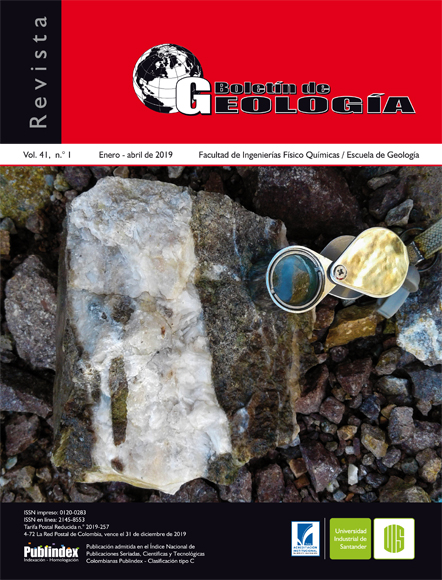Quantitative determination of heterogeneity in samples of rock type plug using X-ray computerized tomography
Published 2019-01-08
Keywords
- Computed tomography,
- plug,
- attenuation coefficient,
- heterogeneity,
- porosity
How to Cite
Altmetrics
Abstract
The X-ray computed tomography (CT), is a technique that allows inspection of the internal structure of the rock in a non-destructive way from images of cuts obtained from the scanning of the samples. This method offers an alternative for the Quantitative determination of heterogeneity in the analysis of samples of rock type plug in terms of porosity, a fundamental property to define hydrocarbons volume present in the reservoir and determining it is one of the basic applications of the CT. Where, using the attenuation coefficients of the CT images the heterogeneity is determined, in order to define how representative the sample is and guarantee the veracity of the results in subsequent tests. In this case, a high heterogeneity was determined for the synthetic samples and a low heterogeneity for the native sample. The significant contribution of this innovative methodology is related to the visualization inside of the rock in a nonintrusive way, this being a unique method that allows to quantify the homogeneity and calculate the porosity of the total volume of the rock without altering the integrity of the sample.
Downloads
References
González-Arias, A. (2012). Las matemáticas y la tomografía. Consultado el 15 de noviembre de 2017. http://www.geocities.ws/cytparatodos/vidaytierra/tomografia/index.htm
Honarpour, M., McGee, K., Crocker, M., Maerefat, N., and Sharma, B. (1986). Detailed core description of a dolomite sample from the Upper Madison
limestone Group. SPE Rocky Mountain Regional Meeting. Billings, USA.
Hunt, P., Engler, P., and Bajsarowicz, C. (1988). Computed tomography as a core analysis tool: Applications, instrument evaluation and image improvement techniques. Journal of Petroleum Technology, 40(9), 1203-1210. doi: 10.2118/16952-PA.
Kantzas, A., Marentette, D., and Jha, K.N. (1992). Computer-assited tomography: from qualitative visualization to quantitative core analysis. Journal
of Canadian Petroleum Technology, 31(9), 48-56. doi: 10.2118/92-09-06.
MacGregor, K., Park, E., Sincock, K., and Piekenbrock, E.J. (1991). Effective unconsolidated core preservation in the arctic environment: An aid to
accurate reservoir evaluation. International Arctic Technology Conference. Anchorage, Alaska.
Martínez, M. (2003). Elaboración de un algoritmo para generar mapas de heterogeneidad a partir de datos petrofísicos de un yacimiento. Tesis, Universidad
Central de Venezuela, Caracas, Venezuela.
Nordtvedt, J., Ebelfort, E., Iversen, J., Sylte, A., Urkedal, H., Vatne, K.O., and Watson, A.T. (1997). Determination of three-phase relative permeabilities from displacment experiments. SPE Formation Evaluation, 12(4), 221-226.
Ortiz, A., Plata, J., Herrera, E., y Santos, N. (2015). Caracterización estática de rocas por medio de tomografía computarizada de rayos X-TAC. Revista Fuentes – El Reventón Energético, 13(1), 57-63. doi: 10.18273/revfue.v13n1-2015005.
Pérez, E.R., Juliao, T.M., y Velásquez, N.A. (2017). Técnicas y metodologías para el cálculo de porosidades asociadas a rocas generadoras. ACIPET 2017. Bogotá, Colombia.
Ramírez, J., Arboleda C., y McCollugh, C. (2008). Tomografía computarizada por rayos X: fundamentos y actualidad. Revista Ingeniería Biomédica, 2(4), 13-31.
Sánchez, D. (2015). Análisis del software ImageJ para el análisis científico de imágenes. Tesis, Escuela Técnica Superior de Ingeniería y Sistemas de
Telecomunicación, Universidad Politécnica de Madrid, Madrid, España.
Siddiqui, S., and Khamees, A. (2004). Dual-energy CTscanning applications in rock characterization. SPE Annual Technical Conference and Exhibition.
Houston, USA. Software Mango. http://ric.uthscsa.edu/mango/mango.html. Software ImageJ. https://imagej.net/Fiji/Downloads.
Wellington, S., and Vinegar, H. (1987). X-Ray Computerized Tomography. Journal of Petroleum Technology, 39(8), 885-898. doi: 10.2118/16983-PA.
Withjack, E., Devier, C., and Michael, G. (2003). The role of X-Ray computed tomography in core analysis. SPE Western Regional/AAPG Pacific
Section Joint Meeting. Long Beach, USA

